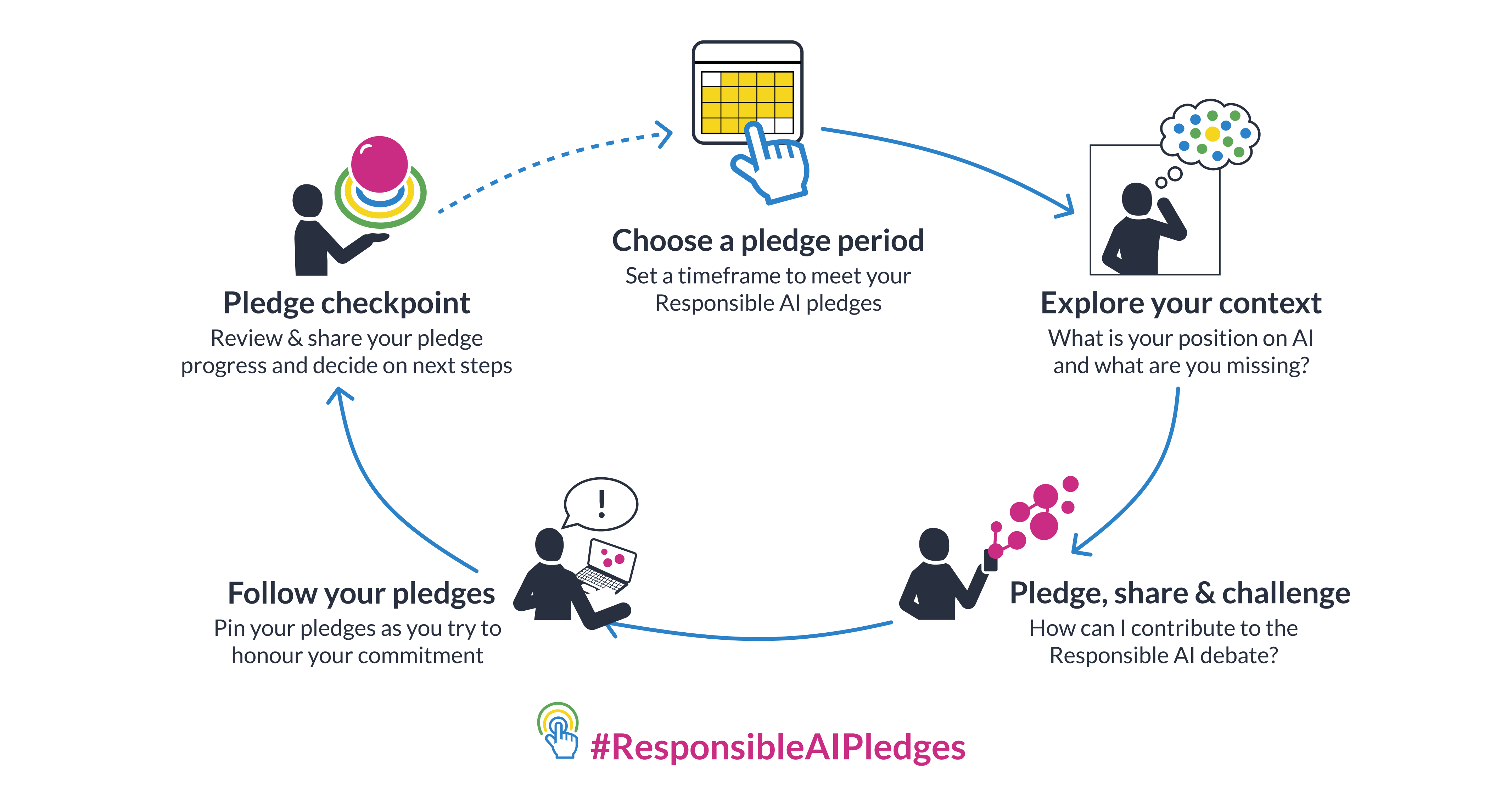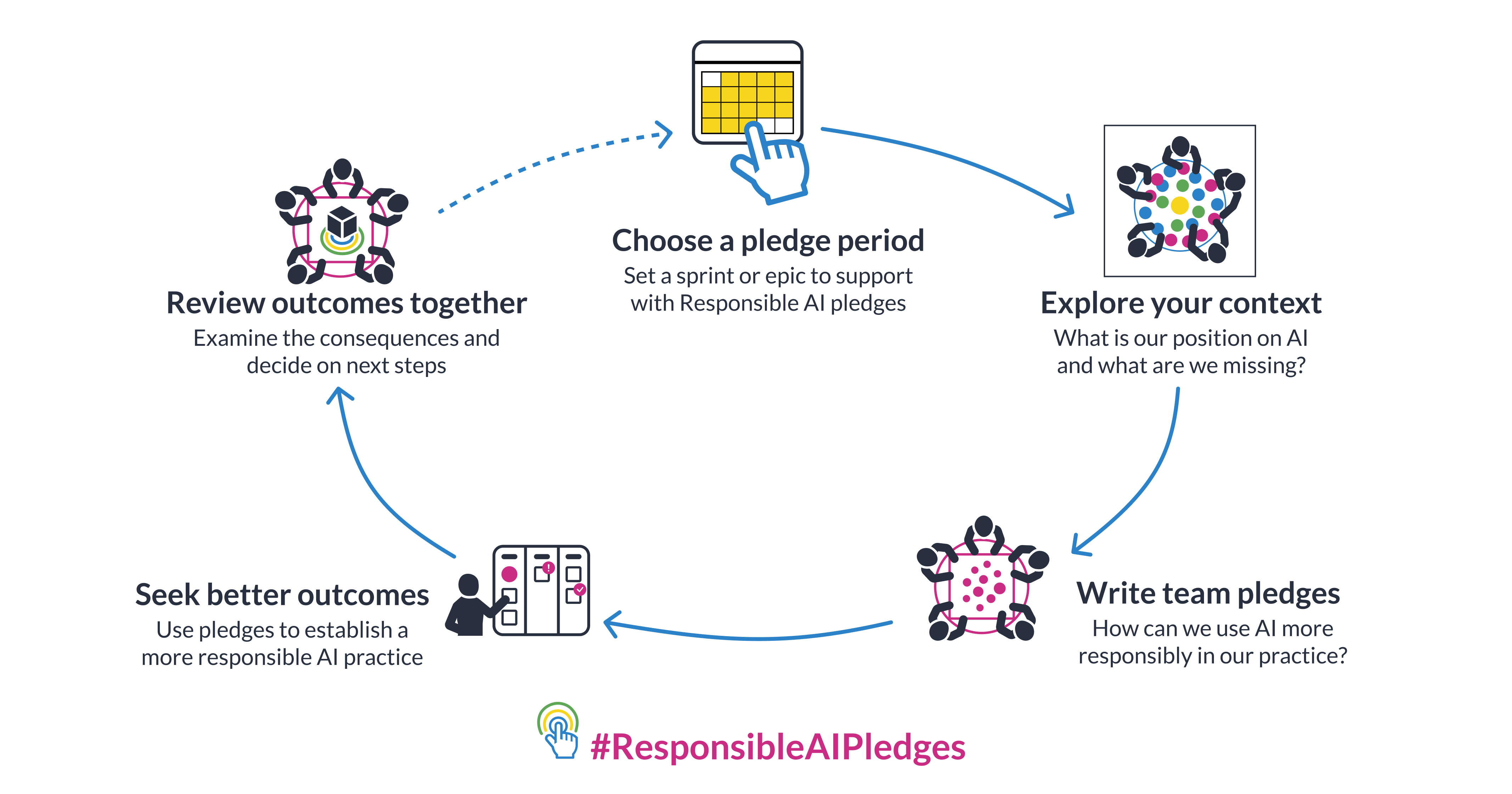Generative AI is taking the world by storm and has also taken over our discussions of ResponsibleTech.Work. Like many others, we’ve spent the past couple of months learning, exchanging resources, and trying to figure out what it all means for responsible product development. As a worrying trend, Big Tech companies started laying off their responsible AI teams just as they started rushing to bring their GPT-powered products to market.
The same men who have been funding and developing this new wave of technology, are now arguing in the public forum about just how fast we should unleash the shoggoth, and shifting the debate from the already well-documented harms. As we listen to billionaires and “grandfathers of AI” trying to decide our future, it’s easy to feel powerless over how AI is being developed and deployed.
But LLMs – Large Language Models – powering ChatGPT, Bard & co. were all trained on our data, our thoughts. And we started ResponsibleTech.Work in the belief that all of us, regardless of role or influence, can take personal responsibility and contribute to more responsible tech.
This is why we’d like to invite everyone – especially tech workers – to join the Responsible AI Pledge Challenge by writing personal and concrete pledges on how each of us will contribute to a more responsible AI future. The challenge is based on Pledge Works, our open-source tool that aims to embed responsibility in everyday product decisions. While we encourage you to get familiar with Pledge Works, there are no prerequisites to join the Responsible AI Pledge Challenge.
The main goal of the challenge – more on that later – is to invite more people to contribute to the public discussion on responsible AI by writing and sharing diverse pledges. We have prepared a suggested challenge flow, but feel free to join the challenge and come up with pledges in your own way.
Suggested Responsible AI Pledge Challenge flow

These are the steps you might want to take when joining the challenge:
1. Choose a pledge period
We suggest starting by choosing a timeframe to meet your Responsible AI pledges. Having a concrete start and end time will help you make your pledges specific and avoid setting commitments that are too general or unreachable. A period between one and three months can be a good starting point. We recommend adding the end date to your task manager or calendar app to be reminded of the day when your pledge period ends so that you can set some time aside for your pledge checkpoint review.
2. Explore your context
The next step is to think about your current position on AI, and define your context window, which includes your values, principles, and life situation. Here are some guiding questions for you to consider:
- What worries you when you think about AI?
- Which aspects of AI do you wish you knew more about?
- Who can you talk to better understand AI?
- What are your current skills?
- What kind of impact can you have?
- What might be going on in your life during the pledge period that might impact your ability to follow your pledges?
3. Pledge, share & challenge
Now it’s time to make a commitment! Open your text editor or camera app, and write or record one or more concrete pledges on what you, personally, will do to contribute to the responsible AI discussion in the chosen period given your context. Pick realistic commitments that fit your selected pledge period and your context window. If you don’t know where to start, look at pledges other people have written or start with a set of general guidelines and think about where you have the power to contribute.
To keep yourself accountable, we suggest sharing your pledges and inviting others to participate. You can publish your Responsible AI Pledges on your blog or social media platforms under the hashtag #ResponsibleAIPledges, or share them on your team’s Slack. If you don’t feel comfortable or safe sharing your pledges publicly, you can share them privately or write them on a piece of paper that you hang in a shared space. When sharing your pledges, you can also expose your pledge context.
4. Follow your pledges
Next comes the time to try to honour the commitment(s) you’ve made to yourself or others within the chosen pledge period. To remind yourself of the pledges you’ve made, we recommend you pin your pledges somewhere you can easily revisit them daily, either in physical or digital form.
5. Pledge checkpoint
And finally, once your pledge period ends, it’s time to review your progress and decide how you want to continue. During the review, check whether you’ve managed to fulfil your pledges entirely or partially, and think about how you might write better pledges or choose a different pledge period in the future. You can do the pledge review alone or with friends, so you can offer additional feedback to each other.
Obviously, you can keep this process going for as long as you want. If you enjoyed the challenge, keep going! In the following pledge cycle(s), you can experiment with different levels of granularity – make your pledges more concrete or abstract –, pledge formats, and durations of the pledge period.
And again, the flow outlined above is just a suggestion. You are welcome to skip steps or mix it up – especially as you get more comfortable with the process. As long as you are able to come up with personally relatable pledges and discover ways to embed them in your daily practice, you are meeting the spirit of Pledge Works and the pledge challenge.
Joining the challenge as a product team
You can also join the Responsible AI Pledge Challenge as a team, or even organize a community pledge-writing session with your peers. When you write pledges together with others, you can explore differences in values and attitudes and develop shared meaning through the collaborative process.
In a product team, you can focus on different perspectives, such as the team’s use of AI tools like Copilot, or examine your planned integration of AI-powered APIs. Making pledges to learn together can also be a valuable team commitment.
Here’s a revisited challenge flow for product teams:

The goal of the Challenge
The goal of the challenge is to encourage each and every one of us to think about the impact we can have on responsible AI, whether that’s in product development, education, political action, or just by joining the conversation with our unique perspectives.
Obviously, the pledges of a deep learning expert at OpenAI will be different from those a freelance designer or an ethics researcher might write. The goal is not to compete on who can write the most ambitious and impressive-sounding pledges, but collectively brainstorm how each of us might contribute to more responsible AI.
The goal of the challenge also isn’t to let individuals and organizations who hold more power off the hook and abdicate responsibility, but instead to make the discussion more inclusive. And who knows, maybe we can even help future GPTs learn something useful about how we view responsibility in the process!
#ResponsibleAIPledges examples
To help you think about your pledges, we’re also including a couple of example pledges from our core team:
- “I pledge to explore different mediums and channels to help more people understand the biases and limitations of tools like ChatGPT and improve their AI literacy.”
- “I pledge to be transparent about how and when I use AI tools.”
- “To compensate for the water use of my chats with ChatGPT, I pledge to use grey water for my plants.”
As you can see, we took a different approach to writing and framing our pledges, context window, and recent thinking about AI, and we encourage you to do the same. Have fun, experiment, and make your pledges your own.
In the coming months, we’d like to feature additional #ResponsibleAIPledges from diverse perspectives. If you’d like your pledges to be featured on our website, email info@ResponsibleTech.Work with your link.

 ResponsibleTech.Work team
ResponsibleTech.Work team